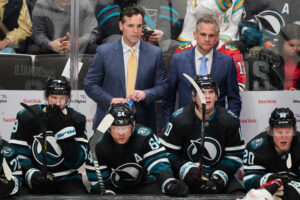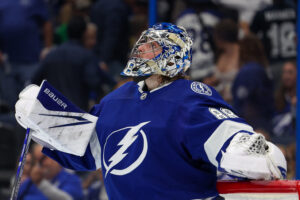The Toronto Maple Leafs off-season has just begun. After they were eliminated in the first round by the Boston Bruins, it left their biggest blemishes exposed, and fans furious. As a result of the crushing defeat, there has been a call for massive changes. From trading William Nylander to dumping Jake Gardiner, there’s a belief that this team needs to make changes. But today let’s look at the boring but best option for the Leafs, be patient.
Options For the Toronto Maple Leafs Off-Season
With the call for big changes to the Leafs this off-season, there are multiple ways which they can change the roster. The first suggestion usually involves William Nylander. Almost every mock trade around the Leafs involves Nylander being moved to help shore up the right side. This is because Nylander is generally viewed as the third best player in the “big three”. Furthermore, he really struggled in the playoffs. As a result, the perception around Nylander is that he should be expendable.
To understand why the Leafs need to be patient, it’s important to put in perspective just how good William Nylander is. To do this, we can turn to goals above replacement (GAR). This is a holistic stat which takes everything that players do into account. Then boils their output down to one number. From there, any players output can be compared to their peers to get an idea of what tier a player is in.
Nylander’s GAR Comparables
At age 21 Nylander provided 12.54 goals above replacement. Among forwards, that ranks him 38th overall. Here’s a look at some of his closest comparables, players who put up similar value at the same age.
 Sure the playoffs were frustrating, but Nylander’s list of comparables should make trading him terrifying. He’s sandwiched between two players considered to be franchise-altering talents. Last off-season the Colorado Avalanche were also in need of help on the blue line. But imagine if they traded Nathan MacKinnon to do so. That trade would likely be one of the worst in recent history.
Sure the playoffs were frustrating, but Nylander’s list of comparables should make trading him terrifying. He’s sandwiched between two players considered to be franchise-altering talents. Last off-season the Colorado Avalanche were also in need of help on the blue line. But imagine if they traded Nathan MacKinnon to do so. That trade would likely be one of the worst in recent history.
Then there’s one spot below Nylander, Jack Eichel. The Buffalo Sabers literally built their team around Eichel, and he is definitely an untouchable. If Buffalo was trying to trade him for a “top four defenseman” it would make them the laughing stock of the NHL.
Farther down the list, there’s an impressive crop of players who Nylander has outperformed at the same age. There are a few superstars like Johnny Gaudreau and Mark Scheifele. Then there are some underrated first line wingers like Brendan Gallagher and Brandon Saad. Finally, there is Mikko Rantanen, a budding star in Colorado.
It’s impossible to know how Nylander will age, but his comparables suggest he can become a superstar in his own right. Elite forwards do not grow on trees, so the Leafs need to be patient with Nylander. Players that good, that young, are the kind you build around, not top four defencemen. Of course, if the Toronto Maple Leafs off-season doesn’t include a Nylander trade, that opens up the possibility for a different kind of panic move in the Toronto Maple Leafs off-season.
Be Patient On the Blue-Line
Without Nylander as a trade chip, it’s entirely possible the Leafs do something else to address their right side on defence. Like over-pay for help in free agency. While they can certainly use an upgrade, a short-sighted, panic move on the blue line would be a mistake. The Toronto Maple Leafs off-season doesn’t have to include a blockbuster for defensive help because their blue line isn’t as bad as people think. Here’s how each player graded this season.
 Not a single player on the right side was even average, but the left side is actually among the best in the NHL. Morgan Rielly finally flourished as a number one defencemen this season. He won the battle against tough competition and has become the number one defenceman the Leafs so desperately needed. And for a cherry on top, he was one of the best power-play producers on the blueline.
Not a single player on the right side was even average, but the left side is actually among the best in the NHL. Morgan Rielly finally flourished as a number one defencemen this season. He won the battle against tough competition and has become the number one defenceman the Leafs so desperately needed. And for a cherry on top, he was one of the best power-play producers on the blueline.
Then there’s Jake Gardiner. Despite his horrible end to the season, he has a proven track record of improving the teams shot and chance differential while he’s on the ice. Add a 50 point season on top of that, and Gardiner’s a number two defenseman on more teams than he’s not. Also, he’s proven he can run an effective second pair. Does he make painful mistakes? Yes. Will game seven leave some fans permanently skeptical of him? Certainly. But in the end, he out shoots, chances and scores the opposition, so who cares?
Finally, there’s Travis Dermott. It’s hard to overstate how impressive his early results are. Among defenders with at least 500 minutes played at even strength, nobody had better-shot differentials relative to their teammates than Dermott. Additionally, he was top 10 in expected goal differential and top 15 in points per hour (From Corsica). Sure it was against soft competition, but if Dermott is running your third pair, your ahead of most teams.
All of this is to say that yes, the Leafs right side is brutal, right near the bottom of the NHL. But the left side has a player who has proven they can run their pairing on each one. As a result, they should be patient with the blue line too. They don’t need to break the bank and pay a premium to make a massive splash. With some small upgrades and roster optimization, they can have a competent right side, and a dominant left one. Altogether, that would make the defence core good enough to win with.
Sure if the Vancouver Canucks are just throwing away Chris Tanev, or John Carlson wants to come to Toronto for a discount, then, by all means, pull the trigger on a move. But the Leafs have no leverage in these scenarios, and upgrading will likely cost more than it’s worth, so be patient, and look for smaller but cheaper upgrades, because the blue-line is better than people think.
Auston Matthews Going Forward
The final reason the Leafs should be in no rush this off-season revolves around Auston Matthews. Like many others discussed in this article, he had a series to forget against Boston, which is why it’s important to look at the grand scheme to see why there is no rush with Matthews.
Again we can use GAR to see what kind of a season Matthews had. He contributed 12.53 goals above replacement, incredibly close to Nylander. Except Matthews did it in 20 fewer games. Pro-rated over a full season, that already makes him a top 20 skater in the NHL. And just like Nylander, Matthews results get even more impressive relative to his age.
 Connor McDavid had to be discluded because he was too good to really be considered “comparable”, but after that, these are the best seasons by 20-year-olds from the past five years, and Matthews tops the list. This is exciting both now and for the future. Given what we know about age curves, players typically improve until age 23-25 and then peak. This means Matthews is already elite and might have half a decade of improvement left. When he finally does peak, he will likely be one of the top five players in the entire NHL.
Connor McDavid had to be discluded because he was too good to really be considered “comparable”, but after that, these are the best seasons by 20-year-olds from the past five years, and Matthews tops the list. This is exciting both now and for the future. Given what we know about age curves, players typically improve until age 23-25 and then peak. This means Matthews is already elite and might have half a decade of improvement left. When he finally does peak, he will likely be one of the top five players in the entire NHL.
This should excite Leafs fans, but also help convince people why the team needs to be patient. Their Leafs franchise centre (and Mitch Marner) could still be half a decade away from their peaks. So now isn’t the time to go all in but mortgage the future. With Nylander, Matthews, and Marner at the helm, this team is going to be good for a long, long time so the Toronto Maple Leafs off-season doesn’t need to have any massive moves, just be patient this summer.
Main Photo: TORONTO, ON – FEBRUARY 9: William Nylander #29 of the Toronto Maple Leafs skates against the St. Louis Blues during an NHL game at the Air Canada Centre on February 9, 2017 in Toronto, Ontario, Canada. The Blues defeated the Maple Leafs 2-1 in overtime. (Photo by Claus Andersen/Getty Images)






